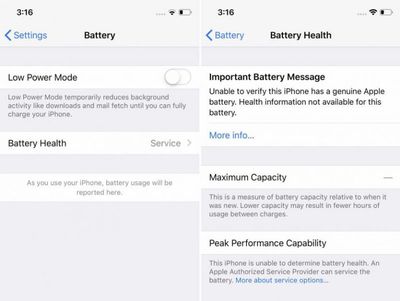Last week, iPhone repair site iFixit highlighted a new iPhone feature described as a "dormant software lock" designed to prevent customers who get unauthorized battery repairs from seeing the battery health of their devices.
On an iPhone XS, XS Max, or iPhone XR, getting a repair from a non-Apple authorized source results in a message that says "Unable to verify this iPhone has a genuine battery," with the iPhone refusing to display battery health information.

Apple today provided a statement on the issue to iMore, confirming that it did indeed introduce "a new feature" last year that brings up the aforementioned message when a non-authorized battery repair is made, with the aim of protecting customers from "damaged, poor quality, or used batteries."
We take the safety of our customers very seriously and want to make sure any battery replacement is done properly. There are now over 1,800 Apple authorized service providers across the United States so our customers have even more convenient access to quality repairs.
Last year we introduced a new feature to notify customers if we were unable to verify that a new, genuine battery was installed by a certified technician following Apple repair processes. This information is there to help protect our customers from damaged, poor quality, or used batteries which can lead to safety or performance issues. This notification does not impact the customer's ability to use the phone after an unauthorized repair.
On an iPhone XR, XS, or XS Max that has a battery replaced outside of an Apple Store or an Apple Authorized Service Provider, the iPhone will simply read "Service" and will provide the messaging about a battery that can't be verified.
The battery health feature that lets customers see the health of their batteries is blocked and not available, with no measurement of maximum capacity or peak performance capacity.
iFixit discovered that this message pops up regardless of the battery being used. An unauthorized repair from a shop using a genuine Apple battery from another iPhone displays the warning message just as a third-party non-Apple battery does.
According to Apple, the notification about the non-genuine battery does not affect a customer's ability to use the phone after the repair, but it is of course going to make customers wary of third-party repair shops that are not authorized by Apple.
The only way to avoid the messaging when getting a battery replacement on an iPhone XS, XS Max, XR (and presumably future iPhones) is to get that repair done through Apple. Apple charges $69 for an out-of-warranty replacement battery in its newest iPhones, which is more expensive than many third-party repair shops.
Repairs are free with AppleCare+ and when iPhones are under the one-year standard warranty, but as these iPhones age and are no longer covered, customers will need to shell out more money for an Apple-certified repair or live with a non-functioning battery health feature.
Research from YouTube channel The Art of Repair suggests that Apple's newest iPhones use a Texas Instruments microcontroller on the battery, which is designed to authenticate the battery.
Repairs from Apple and Apple Authorized Service Providers likely use Apple's proprietary RepairCal diagnostics software to reset the "Service" status when doing a battery replacement, something that can't be replicated by non-Apple repair shops without the required equipment.























